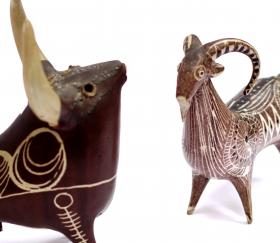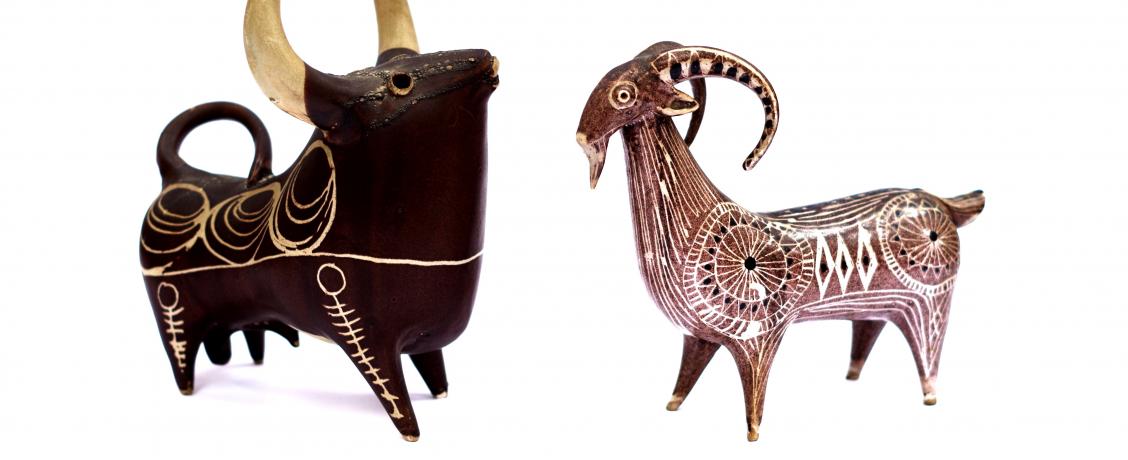A Bull and a Goat went into a Coffee Bar…
A Bull and a Goat went into a Coffee Bar…
by Elizabeth Talbot
Insight into a fascinating, little known era leads neatly to the next Modern Design Sale at Diss Auction Rooms on 14 October.
Dora Billington was born in 1890 to a family of potters in Tunstall, Stoke-on-Trent. She attended Tunstall and Hanley Schools of Art, worked as a decorator for Bernard Moore, then studied at the Royal College of Art and the Slade School of Art. Eventually, as an influential teacher of pottery, she was appointed Head of Pottery at the Central School of Art & Design in London, where she established a department in which pottery was produced with no fixed standards or preferred method. This approach perfectly complemented the contemporary influences of Picasso, just nine years Billington’s senior.
William Newland was born in New Zealand in 1919. He studied painting at the Chelsea School of Art, pottery at the Institute of Education, and ceramics under Billington at the Central School of Art & Design. Ultimately, he became a teacher at both the Central School and the Institute of Education where his students included Margaret Hine and Nicholas Vergette.
Margaret Hine was born in 1927. She studied at Derby School of Art, then at the Central School of Arts & Design under Billington, before being taught by Newland at The Institute of Education. Meanwhile, Nicholas Vergette, who was born in Lincolnshire in 1923, studied with Newland and Hine in London.
Newland and Hine married in 1950 and, with Vergette, collaborated on projects. The three potters shared a studio in Bayswater and exhibitions at the Studio Club, Swallow Street, Piccadilly. Billington recognised the cutting-edge dynamism of this trio, which was distinctive from the new wave of post-war students; in 1955 she described them as having "abundant vitality and originality".
Known as the Bayswater Group and more recently as the Picassoettes, these three artists typified a style of work that grew out of the Central School of Art & Design under Billington’s influence. It was in direct contrast to Bernard Leach’s stonewares of the period, which, borrowing from Oriental techniques, were muted and restrained; the inspiration for the important work of Lucie Rie, Hans Coper and others. By contrast, the Picassoettes were renowned for their use of brightly coloured tin-glazed earthenwares and were a welcome light in the dark, post-war years. They produced ceramic tiles, sculptures and decorative items for several small independently run coffee bars which began to appear in central London in the mid-50’s and not only was the style ground-breaking, but they were making ceramics specifically for public spaces instead of purely functional wares or one-off pieces for exhibitions.
They were making plates which were decorated with Picasso-like imagery and placed on walls to diffuse lights behind them, sculptural pieces for shop-front windows or figures for shelved displays, such as bulls, horses and goats. Their primary concern was pleasing the patron who paid them; so they fitted their style to any theme they were presented with. The new coffee bars, inspired by the Mediterranean, Africa and Latin America, were a sophisticated, colourful and exotic addition to the British high street and were fast becoming the fun, fashionable places to be seen.
In 1958 Vergette went to America and became Professor of Art at the Southern Illinois University School of Art & Design; Newland and Hine continued to work on interior design schemes for coffee bars. Through their association with the Studio Club they met businessmen Phillip and Reggie Kaye. Being new to the catering industry, the Kayes eschewed conventional, established designers and commissioned artists, including Newland and Hine, to create talking points to put the spotlight on their business, ultimately leading to the opening of their famous Golden Egg chain of coffee bar/restaurants in the early 1960s.
Newland and Hine were of their time; their work was fashionable and as with all fashionable things, it would go out of fashion. It was out of fashion by the dawn of the 1970s. Very little of their "coffee bar" work remains and when it is found on the market, it generates a great deal of excitement. Two archetypal works from the early 1950s have been sourced in Norfolk and are to be offered for auction by the decedents of a former owner of the Studio Club, who bought the pieces from its 1954 exhibition. One is a bull, signed Newland, £700 – 1,000, the other a goat, signed Hine, £800 – 1,000. Each is a little damaged but has survived to testify to the swinging Soho scene of 70 years ago.
Please contact Modern Design expert James Bassam j.bassam@twgaze.co.uk for further information regarding valuations and sales.

